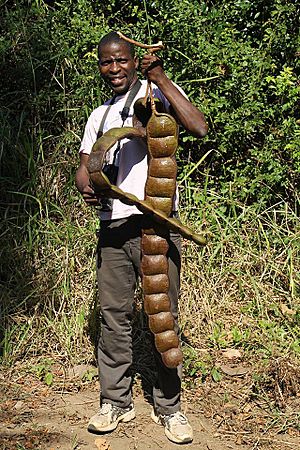African dream herb facts for kids
Quick facts for kids African dream herb |
|
|---|---|
 |
|
| Mature pod in Mozambique | |
| Scientific classification | |
| Kingdom: | |
| (unranked): | |
| (unranked): | |
| (unranked): | |
| Order: | |
| Family: | |
| Genus: |
Entada
|
| Species: |
E. rheedii
|
| Binomial name | |
| Entada rheedii Spreng.
|
|
| Synonyms | |
|
Adenanthera gogo Blanco |
|
Entada rheedii, also known as the African dream herb or snuff box sea bean, is a very large woody climbing plant. In Jamaica, people call it the cacoon vine. Its seeds have a very tough outer shell. This strong shell helps the seeds float in seawater for a long time without getting damaged. This allows them to travel far across oceans.
Contents
Why is it Called Entada rheedii?
The plant's scientific name, Entada rheedii, honors a person named Hendrik Adriaan van Rheede tot Draakestein. He was a Dutch botanist who lived from 1637 to 1691. Even though the correct spelling is rheedii, you might sometimes see it written as Entada rheedei.
Traditional Uses of the African Dream Herb
People in Africa have used Entada rheedii in their traditional medicine for a long time.
Dream-Inducing Properties
Some traditions use the inner part of the seed to help people have very clear and vivid dreams. Sometimes, the seed's inner part is eaten directly. Other times, it is chopped, dried, and mixed with other plants. This mixture might then be used in ways to help bring on the desired dreams before sleep.
Other Medicinal Uses
This plant is also used in other ways. People apply it on the skin to help with problems like jaundice (a condition that makes skin yellow), toothache, and ulcers. It is also used for muscle and bone problems.
Cultural Significance
The seeds of Entada rheedii are very popular. People often use them to make beautiful jewelry. They are also carried as good-luck charms, believed to bring fortune to the owner.
Historical Records in Australia and India
In 1889, a book called The Useful Native Plants of Australia mentioned a similar plant, Entada Scandens, which was known as the "Queensland Bean." Indigenous Australians in the Cleveland Bay area called it "Barbaddah." They would prepare these large beans by heating them in a stone oven. After heating, they would pound the beans into a fine powder. This powder was then placed in a bag and soaked in water for ten to twelve hours before it was ready to be used. People in India also ate these beans after roasting and soaking them in water.
Where Does Entada rheedii Grow?
The seeds of Entada rheedii are often found on beaches in eastern and southern Africa. This plant naturally grows along riverbanks, in areas where rivers meet the sea (estuaries), and in swampy forests.
Because its seeds can travel easily by sea, Entada rheedii is found in many warm, tropical, and subtropical parts of the world. You can find it in tropical Africa, South Africa, tropical Asia, and even in Queensland, Australia.

